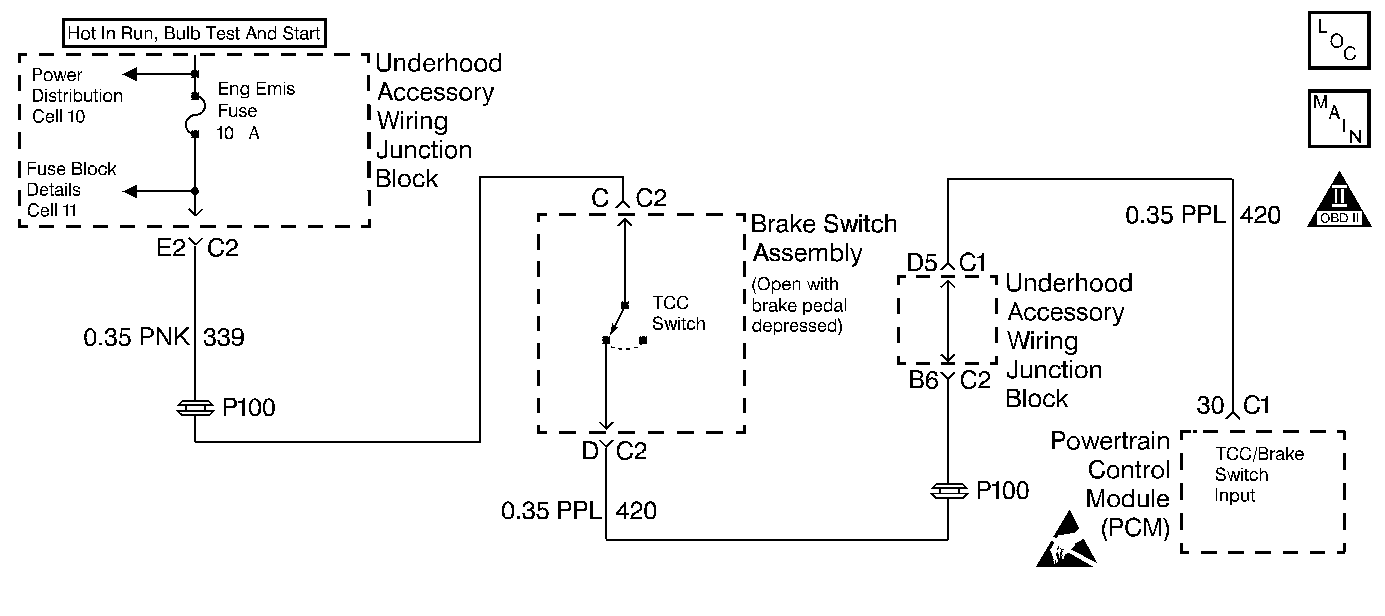
Circuit Description
The brake switch indicates brake pedal status to the Powertrain Control Module (PCM). The brake switch is a normally-closed switch that supplies battery voltage on circuit 420 to the PCM. Applying the brake pedal opens the switch, interrupting voltage to the PCM. When the brake pedal is released, the PCM receives a constant voltage signal. If the PCM receives a zero voltage signal at the brake switch input, and the Torque Converter Clutch (TCC) is engaged, the PCM de-energizes the Torque Converter Clutch Solenoid Valve (TCC Sol. Valve).
The PCM disregards the brake switch input for TCC scheduling if there is a brake switch circuit fault (Refer to Diagnostic Aids).
When the PCM detects an open brake switch (pedal applied) during a number of accelerations, then DTC P0719 sets. DTC P0719 is a type D DTC.
Conditions for Setting the DTC
| • | No VSS DTCs P0502 or P0503. |
| • | The vehicle speed is less than 8 km/h (5 mph). |
| • | Accelerate the vehicle to 32 km/h (20 mph) taking 4 seconds or more. |
| • | The vehicle speed remains above 32 km/h (20 mph) for 6 seconds or more. |
| • | The above conditions must occur more than 7 times, with the brake switch open (no voltage to PCM) for more than 15 minutes, without closing for 2 seconds. |
Action Taken When the DTC Sets
| • | The PCM does not illuminate the Malfunction Indicator Lamp (MIL). |
| • | Disregard the brake switch for TCC scheduling when all of the following conditions are met: |
| - | The throttle position is greater than 6%. |
| - | The vehicle speed is greater than 70 km/h (44 mph). |
| - | The throttle position was previously greater than 12%, while the vehicle speed was greater than 72 km/h (47 mph). |
| - | The brake switch has not been OFF for more than 2 seconds during this ignition cycle. |
Conditions for Clearing the DTC
| • | A scan tool can clear the DTC from the PCM history. The PCM clears the DTC from the PCM history if the vehicle completes 40 warm-up cycles without a failure reported. |
| • | The PCM cancels the DTC default actions when the fault no longer exists and the ignition is OFF long enough in order to power down the PCM. |
Diagnostic Aids
| • | If the PCM detects a brake switch fault, then the brake switch input is disregarded for TCC scheduling. The PCM then uses throttle position and vehicle speed input to determine TCC application and release. Use of these inputs may result in a noticeable harsh apply or abrupt release of the TCC. |
| • | Ensure that the brake switch is properly adjusted. |
| • | Inspect the wiring at the PCM, the brake switch connector and all other circuit connecting points for the following conditions: |
| - | A bent terminal |
| - | A backed out terminal |
| - | A damaged terminal |
| - | Poor terminal tension |
| - | A chafed wire |
| - | A broken wire inside the insulation |
| - | Moisture intrusion |
| - | Corrosion |
| • | When diagnosing for an intermittent short or open condition, massage the wiring harness while watching the test equipment for a change. |
Test Description
The numbers below refer to the step numbers on the diagnostic table.
Step | Action | Value(s) | Yes | No | ||||
|---|---|---|---|---|---|---|---|---|
1 | Was the Powertrain On-Board Diagnostic (OBD) System Check performed? | -- | Go to Powertrain On Board Diagnostic (OBD) System Check in Engine Controls | |||||
2 |
Important: Before clearing the DTCs, use the Scan Tool in order to record the Failure Records for reference. The Clear Info function will erase the data. Are DTCs P0753, P0758 or P0740 also set? | -- | ||||||
3 | Inspect the ENG EMIS fuse for an open. Was a condition found and corrected? | -- | -- | |||||
4 | Inspect circuits 339 and 420 for a short to ground. Repair circuits 339 and 420 if necessary. Refer to General Electrical Diagnosis in Wiring Systems. Was a condition found and corrected? | -- | Go to Diagnostic Aids | |||||
Does the Brake Switch status change from Open to Closed? | -- | |||||||
6 | Replace the Brake Switch. Refer to Stop Lamp Switch Replacement in Hydraulic Brakes. Is the replacement complete? | -- | -- | |||||
7 | Inspect circuits 420 and 339 for an open. Repair circuits 420 and 339 if necessary. Refer to General Electrical Diagnosis in Wiring Systems. Was a condition found and corrected? | -- | ||||||
8 | Inspect PCM connector C1 (Blue) for bent, damaged or backed out connector pins. Was a condition found and corrected? | -- | ||||||
9 | Replace the PCM. Refer to Powertrain Control Module Replacement/Programming in Engine Controls. Is the replacement complete? | -- | -- | |||||
10 | In order to verify your repair, perform the following procedure:
Has the test run and passed? | -- | System OK |
